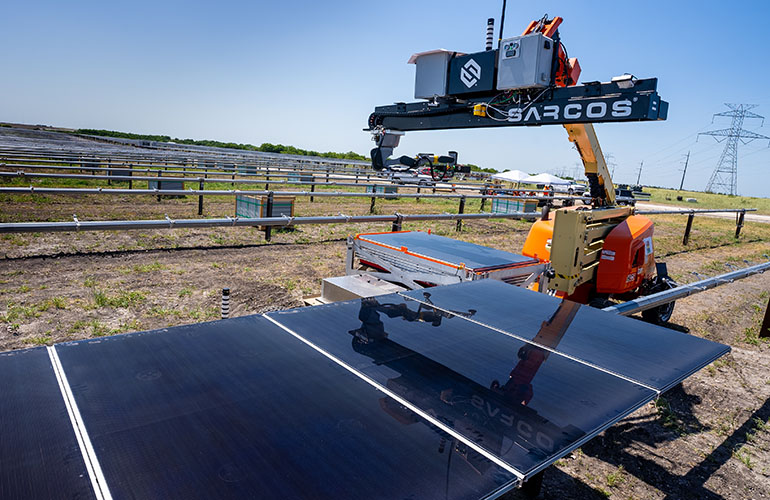|
Listen to this article  |

Sarcos and Blattner will be refining Sarcos’ solar panel installing robot. | Source: Sarcos
Sarcos Technology and Robotics Corporation and Blattner Company have signed an agreement to further develop Sarcos’ autonomous robotics solar construction system. The companies will evaluate and further refine the technology, functionality, and safety of the system through a series of field trials that will occur over the next several years.
Blattner will be providing funding, expertise, and facilities for testing. Sarcos plans to test its system in varying environmental conditions across different sites to prepare for its commercial launch, which is currently estimated for late 2024.
Sarcos’ system is an autonomous mobile robotic system designed to optimize employee safety and enhance the efficiency of the installation of photovoltaic (PV) modules for utility-scale solar projects. It builds upon its Ourdoor Autonomous Manipulation of Photovoltaic Panels (O-AMPP) project, which began in 2021 and completed its demonstration in March 2023.
“We are extremely optimistic about the use of robots for solar construction to help address the workforce shortages, productivity, and safety challenges that are currently slowing down the progress of U.S. solar initiatives,” Matt Hadsell, Senior Manager of Innovation and Development at Blattner, said. “We are committed to working with Sarcos to refine their autonomous robotic solar construction system so that we can be one step closer to achieving our nation’s clean energy goals.”
Sarcos’ O-AMPP project is funded through the US Department of Energy’s Solar Energy Technologies Office (SETO) and aims to streamline the process of solar field construction. According to the Solar Energy Industries Association (SEIA), annual solar installations will need to increase by 60% through 2030 to meet climate targets, and this will require almost 800,000 new solar workers.
“Like many industries, the solar construction industry is experiencing significant worker shortages post-COVID and has not yet recovered,” Laura Peterson, Interim President and CEO of Sarcos, said. “Our autonomous robotic solar construction system is expected to ease these workforce challenges while improving overall safety and speed in the solar installation process.”
Systems like O-AMPP can help to reduce the sector’s reliance on labor while also increasing efficiency. The system can deliver, detect, lift, and place PV modules in the field. Its goals are to improve worker safety and productivity, improve construction speed, and improve installation quality.
This partnership is in line with Sarcos’ latest company optimization plan, which includes cutting costs and focusing on robotic systems that show the greatest market traction. In particular, Sarcos planned to focus on robotic systems for the subsea, aviation, and solar end markets.
Credit: Source link


Comments are closed.